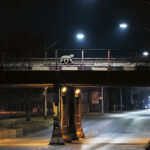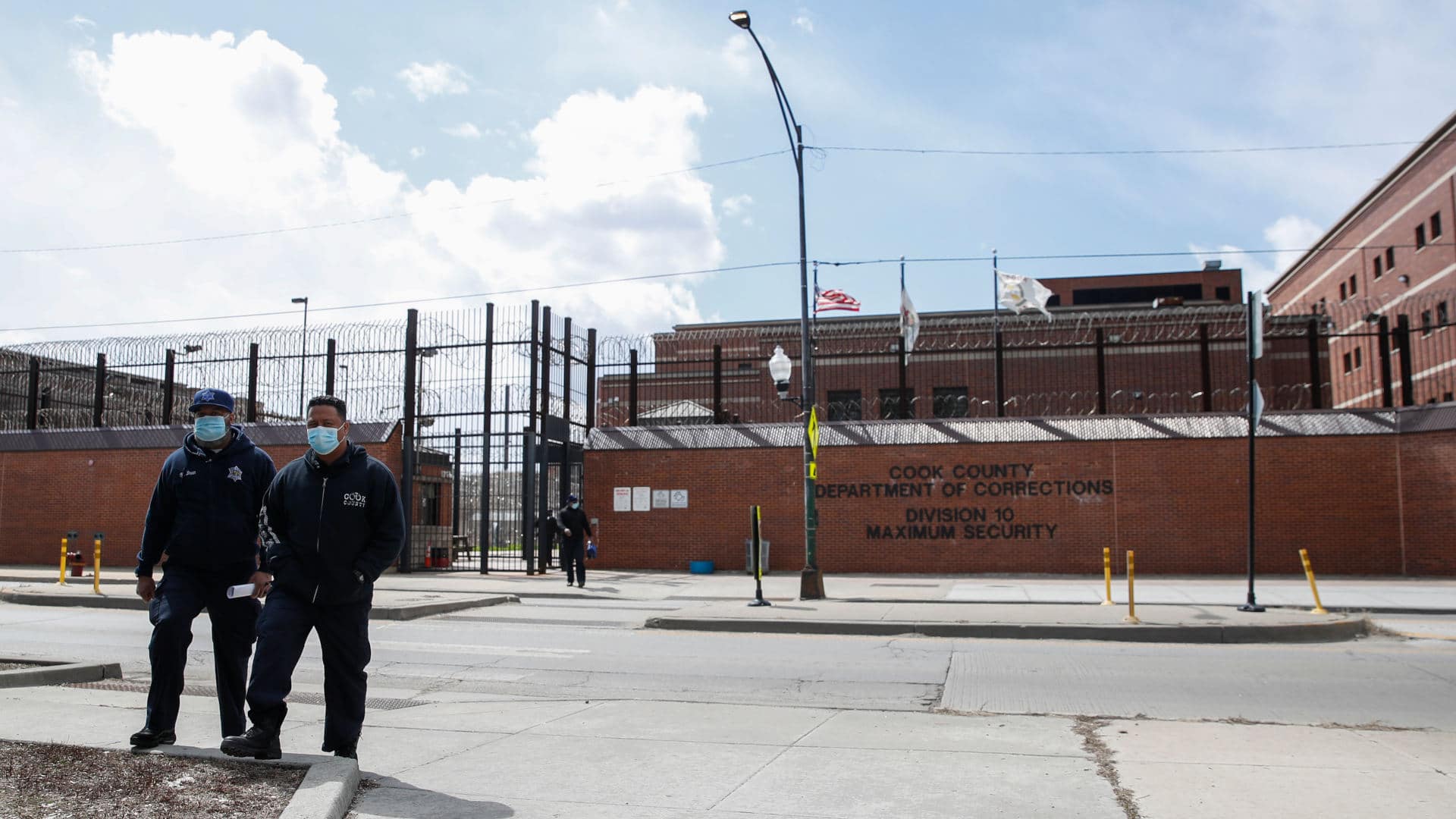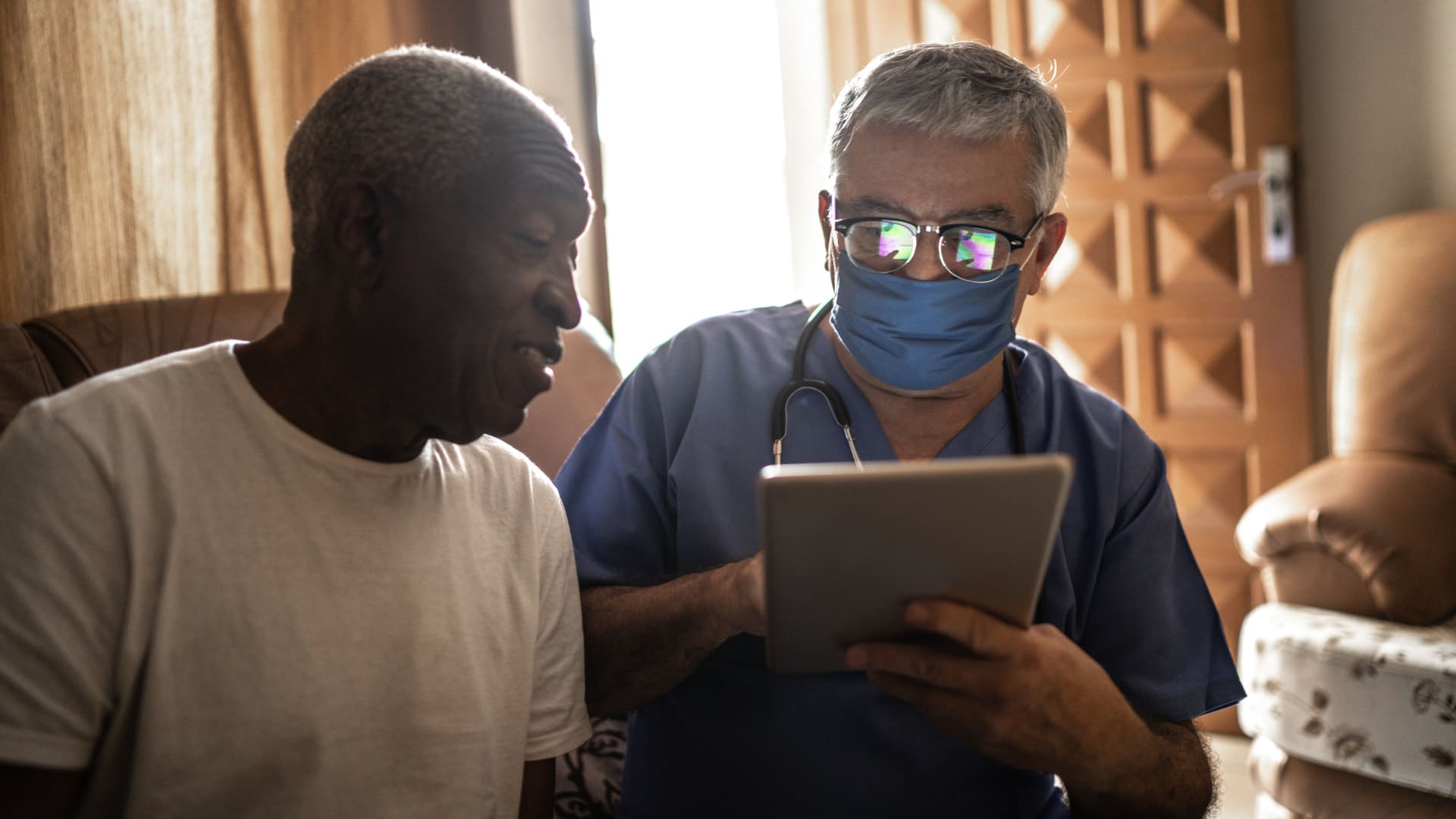Drive about 20 minutes southwest of downtown Chicago and you will notice the change in landscape as you approach 26th Street and California Avenue. Just inside the Little Village neighborhood is a 25-foot concrete wall, many rows of razor-wire fencing, and, behind that, intimidating brick and concrete architecture. These are the conspicuous visual cues of an urban correctional institution. Encompassing nearly 100 acres, the Cook County Department of Corrections is one of the largest single-site jails in the country. The jail currently houses about 5,400 detainees daily, most of them awaiting trial, and employs more than 3,000 staff. The County, as it’s known across Chicago, has been cited for a laundry list of civil rights violations since the 1970s, including excessive use of physical force, rodent infestation, and periods when overcrowding was so severe that detainees were forced to sleep on floors.
This year, the County earned another dubious distinction: It was home to one of the country’s largest Covid-19 outbreaks at the height of the pandemic in the spring. By the end of April, 628 detainees and 279 staff had tested positive, according to a recent review by researchers from Cook County and the Centers for Disease Control and Prevention. At least nine people died during the period.
In an effort to contain the virus that causes Covid-19, SARS-CoV-2, jail administrators undertook “aggressive intervention strategies,” according to the study. These strategies including universal mask wearing, rapid testing, and isolation of infected individuals. Further, about 1,600 detainees were released to relieve overcrowding. As of the most recent update, the outbreak is largely under control inside the jail. Twenty nine detainees are virus-positive, along with 44 employees.
Yet an underappreciated paper published in June suggests that the virus outbreak rippled far beyond those concrete walls. Appearing in Health Affairs, a leading journal of health policy research, the study assessed the effect of jail cycling — the constant traffic of detainees, staff, visitors, vendors, and law enforcement in and out of these facilities. The analysis showed that 16 percent, or about one in every six, of all Covid-19 cases in Chicago and across Illinois could be traced to people cycling in and out of Cook County Jail. As a result, the authors reveal a strong correlation between incarceration and Covid-19 cases in the region, especially in African American communities.
According to the researchers, this is the first paper to document community spread of Covid-19 from mass incarceration. More research is now underway to determine whether the findings will generalize widely, but given that so many jails and prisons have been the site of Covid-19 hotspots, the authors suggest that their findings will be broadly relevant. The study ties into a larger body of literature on incarceration as a public health crisis, which many say deserves renewed attention in light of the Covid-19 pandemic.
Indeed, prior studies show that the formerly incarcerated face a higher risk of premature death and are more likely to experience asthma, certain cancers, hypertension, substance abuse, mental illness, and infectious diseases such as tuberculosis and hepatitis C. Emerging literature suggests that the female partners and children of incarcerated men experience negative health effects, too. Because African Americans are incarcerated at five to six times the rate of Whites — and are sentenced more severely than Whites for similar crimes — these health disparities disproportionately impact Black communities.
Cook County Jail processes about 100,000 people each year. Early in the pandemic, the jail cycling exerted a “multiplier” effect on new infections, researchers believe. Former detainees were released to communities mostly across Chicago and Cook County, but many ranged farther. The data show that between February and April, each person who cycled through the jail was responsible for an average of 2.2 new Covid-19 infections across the state. People living in Peoria, for example, were indicated to be at increased risk of exposure to the novel coronavirus because of conditions at a jail more than 150 miles away, the findings suggest.
To document the role of jail cycling in Covid-19 community spread, the researchers utilized data broken down by zip code. They analyzed the relationship between jail cycling and the rate of Covid-19 by looking at the number of detainees released to each zip code and the corresponding number of infections, while also analyzing other variables that might have influenced transmission rates. Their findings were striking: “Jail-community cycling far exceeds race, poverty, public transit use, and population density as a predictor” of the spread of Covid-19 infections, the authors wrote.
African Americans comprise about 30 percent of Chicago’s population but are almost 75 percent of the detainee population at Cook County Jail. They also represent a plurality — 42 percent — of the city’s Covid-19 deaths. Jail cycling is much more common among residents living in African American communities because of hyper-policing and racial bias across the criminal justice system, said the Health Affairs paper’s lead author, Eric Reinhart, a fourth-year medical student at the University of Chicago Pritzker School of Medicine who is also completing a Ph.D. in anthropology at Harvard. This could account for the significant racial disparities in the spread and impact of Covid-19 across the country, he said.
The idea for the research came from observations made inside Cook County Jail while interviewing detainees as part of his doctoral research, Reinhart said. The jail processes about 300 people every day. They stand in line or sit and wait, sometimes for hours and always in crowded spaces. “If one of those people is infected with SARS-CoV-2,” Reinhart said, “by the end of that processing period, a lot of other people are going to be exposed.”
From his vantage point inside the jail, the problem was obvious: “I thought, this is definitely going to be an important driver of community spread of Covid-19.”
Spokespersons for the Cook County Sheriff’s Office have strongly criticized the paper, noting that the analysis wasn’t able to prove that infections inside the jail caused infections in the broader community. “It is equality plausible that Covid-19 positive people coming from the community introduced infection into the jail, or simply that these communities have high infection rates independent of the jail,” wrote Stephanie R. Black, a physician-epidemiologist with the Chicago Department of Public Health, in a June 19 letter to the executive editor of Health Affairs.
For his part, Reinhart doesn’t dispute that some positive cases came into the jail from the community: “The jail doesn’t create cases out of nothing. No one is saying that.” Instead, he said, “the jail seems to act as a multiplier” that ultimately leads to even more infections after detainees are released into communities.
The researchers have collected additional longitudinal data showing relatively low rates of Covid-19 infection in Chicago beginning in March. The neighborhood infection rates spiked three weeks later, he said, after the jail rapidly released hundreds of detainees.
More research will help determine how well the Health Affairs findings generalize to other regions, but there’s reason to believe this could be happening across the country. About 2.3 million people are detained in state and federal prisons, local jails, and juvenile detention facilities. Overcrowding, poor sanitary conditions, and inadequate health care have turned many jails and prisons into Covid-19 hotspots. As of October 20, more than 150,000 incarcerated people and more than 34,000 staff have tested positive, according to The Marshall Project. More than 1,300 people in total have died.
In an effort to slow the spread of the coronavirus, Illinois halted intakes from county jails to state prisons in late March, and officials in California and Oklahoma ordered similar measures. New York City released about 2,500 from Rikers Island. Up to 17,600 California inmates are expected to be released early, reports The Los Angeles Times.
The early releases are occurring alongside a broader movement to reduce the number of people held in custody from coast to coast.
“It’s shocking and shameful that they are doing what should have been done before,” said Rueben C. Warren, the director of Tuskegee University’s National Center for Bioethics in Research and Health Care, which is the first national bioethics institute to focus on medical care and clinical research in African American communities. “Why did you need a pandemic to do the right thing? African Americans are disproportionately incarcerated, and unfortunately, many are incarcerated who have not committed a crime.”
According to the Prison Policy Initiative, a nonprofit devoted to criminal justice reform, the overwhelming majority of people in local jails — about 74 percent — have not been convicted of any crime. They are awaiting trial and most cannot afford bail.
Warren predicted the pandemic’s significant racial disparities — and its likely spread across correctional facilities — in “The African American Petri Dish,” a paper he and Ronald L. Braithwaite of the Morehouse School of Medicine published in March in The Journal of Health Care for the Poor and Underserved. “Those citizens living in high density areas represent clusters of petri dishes,” they wrote, “much like the jails and prisons with disproportionately high numbers of Black and Brown people held captive (in yet another petri dish).”
The petri dish metaphor came up several times during my reporting for this column, including in an interview with Abdul El-Sayed, a physician-epidemiologist who led the Detroit Health Department from 2015 to 2017. El-Sayed has called on the CDC to pursue a national decarceration strategy during this pandemic.
“We know the most important way to prevent the spread of this disease is physical distancing and basic hygiene practices such as washing your hands regularly and using hand sanitizer. None of those things are possible in jails and prisons,” El-Sayed told me. “So, if you are serious about public health — which I know CDC is — then decarceration has to be a primary goal.”
The Health Affairs research, he added, “demonstrates exactly what happens when you fail to make decarceration — particularly in jails, but also in prisons — a priority. Because what happens in jails is you are creating a petri dish for the spread of this virus and then allowing people back into the world.”
To determine whether jail cycling could explain Covid-19 racial disparities nationwide, Reinhart and his co-lead author on the Health Affairs paper, Daniel L. Chen of the Toulouse School of Economics and the World Bank, are conducting a national data analysis. So far they are noticing similar trends and “a very significant association” between jail cycling and community spread, Reinhart said.
Another paper by Reinhart and Chen currently under review finds that high levels of arrests and mass incarceration could reduce or even negate the positive benefits of social distancing and stay-at-home orders in some areas. The researchers developed a statistical model to analyze each county in the country and the most significant effects are seen in counties with larger African American populations, Reinhart said.
Researchers across disciplines have long argued that hyper-policing African American communities is counterproductive and can lead to unemployment and homelessness among the formerly incarcerated, for example, as well as negative individual and community health outcomes.
“When you have the concentrated levels of incarceration that you see in the Black community, for example, those things are going to cause real problems,” said Robynn Cox, a labor economist, speaking with me from her office at the University of Southern California. Cox specializes in the economic, health, and social effects of mass incarceration. More research should be done to study the formerly incarcerated, a vulnerable population whose health can impact communities, she added.
While some states and cities have released detainees and inmates early due to the pandemic, it is possible that these efforts will allow disparities to persist. New Jersey provides a case in point. State officials fast-tracked legislation and policies to reduce sentences. “We saw some rapid policy decisions in New Jersey in mass release programs in different jurisdictions across the state. We found it was reducing incarceration,” said April Frazier Camara, director of Defender Legal Service Initiatives at the National Legal Aid and Defender Association. But, she said, White prisoners were more likely to be released through the programs. “I have not seen any strategy that also reduces racial disparities,” she said.
Some decarceration and health advocates in Chicago have made similar claims about the early releases at Cook County Jail.
Frazier Camara co-authored a recent report that aims to address these disparities by calling for “racially responsive strategies and resources” during the pandemic. The report was developed by the Black Public Defender Association and the Center for Justice Research, a think tank focused around mass incarceration reform based at Texas Southern University, a historically Black university. The “Save Black Lives” report also advocates for more research, funding and, attention to be directed toward community, social, and public health investments.
Each year in Michigan, for instance, “it costs $33,000 to incarcerate someone,” said El-Sayed. “For $33,000 you can also send someone to the University of Michigan. I would much rather invest in the latter than the former.”
Rod McCullom is a Chicago-based science journalist and reports the “Convictions” column for Undark. His work has been published by Undark, Scientific American, Nature, The Atlantic, and The Nation, among other publications.












Comments are automatically closed one year after article publication. Archived comments are below.
As is the case here in the UK, who cares if Black people living in prison live or die? Only their loved ones and a handful of campaigners. What an indictment of two societies which throw people on the trash heap instead of recognising all our common humanity.